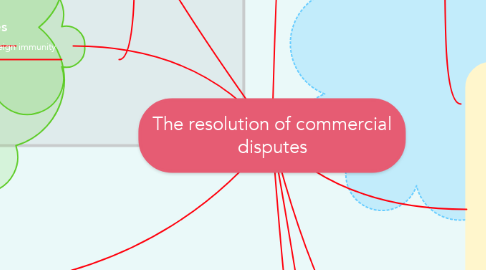
1. Conflict of Laws
1.1. Summary
1.1.1. Refers to the rules by which courts determine which jurisdictions laws applies to a case
1.2. Factors that affect it
1.2.1. Place of contracting, place of negotiations, place of performance, place of business for parties involved and location of subject matter.
1.3. Choice of law Clauses
1.3.1. Clauses in which parties stipulates the country or jurisdiction whose law will apply
1.4. Sovereign immunity
1.4.1. Clauses in which parties stipulates the country or jurisdiction whose law will apply
2. Arbitrator Qualities
2.1. Summary
2.1.1. Commonly referred to as "alternative dispute resolution, arbitration is an alternative method of conflict resolution. Those who may be attempting to settle disputes outside of a court can call upon an arbitrator. They assist and are also responsible finding a resolution by taking on the role as a judge in a less formal environment than regular trial courts
3. Arbitration Advantages
3.1. 1
3.1.1. Generally management and labor representatives are satisfied
3.2. 2
3.2.1. The process is handled by an impartial 3rd party who makes a decision. Evidence is gathered, reviewed and compared to other similar cases. The decision is final and binding
3.3. 3
3.3.1. Parties are able to present their case under oath. Decision is based on facts, evidence and law. An arbitrator reviews and provides an award
4. Arbitration Disadvantages
4.1. 1
4.1.1. There are three general scrutiny’s with arbitration. The cost, the length of time it takes and the process. Each year the cost increase due to the fees and expenses charged by the arbitrator
4.2. 2
4.2.1. The average time to process a grievance through arbitration is approximately 250 days. Many employer are put off by the length of time
4.3. 3
4.3.1. “Creeping Legalism” is the reason the cost and length of arbitration has increased. This is due more cases uses attorneys as arbitrators.
5. Litigation
5.1. Summary
5.1.1. Litigation is a process for handling disputes in the court system. Litigation is a contested action, where someone else, such as a judge may make the final decisions for the parties unless the parties settle before trial. Settlement can happen at any point during the process.
5.2. Jurisdiction
5.2.1. Power of a court to hear and decide a case. Venue is the geographical location
5.2.2. Territorial, In Rem and subject matter. In Personam: Jurisdiction over the person and is based on fairness. European community: determined by domicile of defendant. China: Nonresident defendant must have connection to China. Internet Age: See Elayaan v Sol Media (2008)
5.3. Forum non conveniens
5.3.1. Discretionary power of a court to hear a case
6. Mediatior Qualities
6.1. Summary
6.1.1. The United States does not have a certification or standard to be a mediator. However, there are qualifications required which can vary from state to state. Court certified mediators are placed on a list that the public can access to obtain their availability to resolve disputes (Kelly, 2017).
7. Mediation Advantages
7.1. 1
7.1.1. Generally the cost of mediation is lower than the cost of arbitration
7.2. 2
7.2.1. In mediation the process is much less formal, the parties are able to be actively involved. Mediation is much less stressful than litigation. The best thing about mediation is that the parties control the process and the outcome, not the judge and not the jury. The process is expedited more quickly
7.3. 3
7.3.1. The mediator is able to assist both sides in understanding the other side’s interest. Information is exchanged on a voluntary basis
8. Mediation Disadvantages
8.1. 1
8.1.1. The mediator does not control the outcome
8.2. 2
8.2.1. Settlement only occurs with parties consent
8.3. 3
8.3.1. Mediation may not be the best recourse for certain issues
